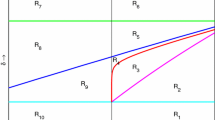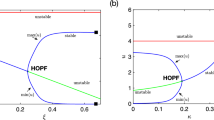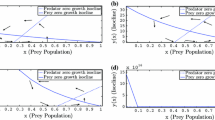Abstract
Our ecosystem is full of various types of food chain systems. Most of the species have more than one food source with various kinds of possible interactions. In this work, we have studied a predator-prey-subsidy model in a rapidly fluctuating environment. As per our consideration predator exploits both a prey population and an allochthonous resource which is provided as a subsidy to the system exogenously, with Holling Type II response functions. Furthermore, we have introduced Gaussian white noise to the main parameters subject to coupling of a prey-predator pair with its environment. We have examined the existence of unique global positive solutions for both the deterministic and stochastic systems. Boundedness, uniform continuity, global attractiveness in mean of solutions of the stochastic system are proved. Conditions for extinction of prey and predator population are derived and the importance of environmental noise as well as subsidy for extinction is discussed through mathematical results and numerical findings. We have derived conditions for persistence of the proposed stochastic system. The results of persistence and extinction have been justified by numerical simulations. Numerically we have found that presence of subsidy can be the cause of survival of predator even there is no prey available for consumption which fact is different from the studies of those systems where additional food is provided for predator. We have also observed that very high input of subsidy can be a cause for extinction of prey population.






Similar content being viewed by others
References
Adams LG, Farley SD, Stricker CA, Demma DJ, Roffler GH, Miller DC, Rye RO (2010) Are inland wolf-ungulate systems influenced by marine subsidies of pacific salmon? Ecol Appl 20(1):251–262
Baalen MV, Krivan V, Rijn PCJ, Sabelis MW (2001) Alternative food, switching predators, and the persistence of predator-prey systems. Am Nat 157:512–524
Barbalat I (1959) Systems dequations differentielles doscillations nonlinearies. Rev Roum Math Pure Appl 4(2):267–270
Barnes VG Jr (1990) The influence of salmon availability on movements and range of brown bears on southwest kodiak island. Bears, pp 305–313
Ben-David M, Bowyer R, Duffy L, Roby D, Schell D (1998) Social behavior and ecosystem processes: river otter latrines and nutrient dynamics of terrestrial vegetation. Ecology 79(7):2567–2571
Bera SP, Maiti A, Samanta GP (2016) Stochastic analysis of a prey-predator model with herd behaviour of prey. Nonlinear Anal. Model. Control 21(3):345–361. https://doi.org/10.15388/NA.2016.3.4
Chesson PL (1984) Variable predators and switching behavior. Theor Popul Biol 26:1–26
Comins HN, Hassell MP (1976) Predation in multi-prey communities. J Theor Biol 62:93–114
Darimont CT, Paquet PC, Reimchen TE (2008) Spawning salmon disrupt trophic coupling between wolves and ungulate prey in coastal British Columbia. BMC Ecol 8(1):14
Das Amartya, Samanta GP (2018) Stochastic prey-predator model with additional food for predator. Physica A 512:121–141. https://doi.org/10.1016/j.physa.2018.08.138
Das Amartya, Samanta GP (2018) Modelling the fear effect on a stochastic prey-predator system with additional food for predator. J Phys A: Math Theor 51:465601. https://doi.org/10.1088/1751-8121/aae4c6
Das Amartya, Samanta GP (2020) A prey-predator model with refuge for prey and additional food for predator in a fluctuating environment. Physica A 538:122844. https://doi.org/10.1016/j.physa.2019.122844
Das Amartya, Samanta GP (2020) Modelling the fear effect in a twospecies predatorprey system under the influence of toxic substances, Rendiconti del Circolo Matematico di Palermo Series 2, https://doi.org/10.1007/s12215-020-00570-x
Erbach A, Lutscher F, Seo G (2013) Bistability and limit cycles in generalist predator-prey dynamics. Ecol Complex 14:48–55
Holling CS (1959) The components of predation as revealed by a study of small-mammal predation of the European pine sawfly. Can Entomol 91(5):293–320
Jana D, Samanta GP (2014) Role of multiple delays in ratio-dependent prey-predator system with prey harvesting under stochastic environment. Neural Parallel Sci Comput 22:205–222
Jana D, Banerjee A, Samanta GP (2017) Degree of prey refuges: control the competition among prey and foraging ability of predator. Chaos Solitons Fractals 104:350–362. https://doi.org/10.1016/j.chaos.2017.08.031
Ji C, Jiang D (2011) Dynamics of a stochastic density dependent predator-prey system with Beddington-DeAngelis functional response. J Math Anal Appl 381:441–453
Kimbrell T, Holt RD (2005) Individual behaviour, space and predator evolution promote persistence in a two-patch system with predator switching. Evol Ecol Res 7:53–71
Lande R (1993) Risks of population extinction from demographic and environmental stochasticity and random catastrophes. Am Nat 142:911–927
Maiti A, Samanta GP (2005) Deterministic and stochastic analysis of a prey-dependent predator-prey system. Int J Math Educ Sci Technol 36(1):65–83. https://doi.org/10.1080/00207390412331314980
Maiti A, Samanta GP (2006) Deterministic and stochastic analysis of a ratio-dependent prey-predator system. Int J Syst Sci 37(12):817–826. https://doi.org/10.1080/00207720600879252
Maiti A, Patra B, Samanta GP (2006) Sterile insect release method as a control measure of insect pests: a mathematical model. J Appl Math Comput 22(3):71–86
Maiti A, Jana MM, Samanta GP (2007) Deterministic and stochastic analysis of a ratio-dependent predator-prey system with delay. Nonlinear Anal Model Control 12(3):383–398
Maiti A, Sen P, Samanta GP (2016) Deterministic and stochastic analysis of a preypredator model with herd behaviour in both. Syst Sci Control Eng 4(1):259–269. https://doi.org/10.1080/21642583.2016.1241194
Manna D, Maiti A, Samanta GP (2018) Deterministic and stochastic analysis of a predator-prey model with Allee effect and herd behaviour. Simulation. https://doi.org/10.1177/0037549718779445
Mao X (2011) Stochastic differential equations and applications. Woodhead Publishing, Oxford
May RM (1973) Stability in randomly fluctuating deterministic environments. Am Nat 107:621–650
Morozov A, Petrovskii S (2013) Feeding on multiple sources: towards a universal parameterization of the functional response of a generalist predator allowing for switching. PLoS ONE 8(9):e74586
Murdoch WW (1969) Switching in general predators: experiments on predator specicity and stability of prey populations. Ecol Monogr 39:335–354
Murdoch WW, Oaten A (1975) Predation and population stability. Adv Ecol Res 9:1–131
Nevai AL, Van Gorder RA (2012) Effect of resource subsidies on predator-prey population dynamics: a mathematical model. J Biol Dyn 6(2):891–922
Parshad RD, Bhowmick S, Quansah E, Basheer A, Upadhyay RK (2016) Predator interference effects on biological control: the paradox of the generalist predator revisited. Commun Nonlinear Sci Numer Simul 39:169–184
Rosenzweig ML, MacArthur RH (1963) Graphical representation and stability conditions of predator-prey interactions. Am Nat 97(895):209–223
Roth JD (2002) Temporal variability in arctic fox diet as reflected in stable-carbon isotopes; the importance of sea ice. Oecologia 133:70–77
Samanta GP (1990) Fluctuation and stability in a diffusive predator-prey system. Appl Math Lett 3(3):115–118
Samanta GP (1991) Stochastic analysis of a noisy oscillator. Appl Math Lett 4(2):61–63
Samanta GP (1992) Complex stochastic averaging approach to a two-state predator system. Int J Math Educ Sci Technol 23(5):739–744. https://doi.org/10.1080/0020739920230513
Samanta GP (1993) Logistic growth under colored noise, Bulletin Mathmatique De La Socit Des Sciences Mathmatiques De Roumanie 37(85):115–122. JSTOR, www.jstor.org/stable/43678527
Samanta GP (1994) Stochastic analysis of a prey-predator system. Int j Math Educ Sci Technol 25(6):797–803. https://doi.org/10.1080/0020739940250603
Samanta GP (1996) The effects of random fluctuating environment on interacting species with time delay. Int J Math Educ Sci Technol 27(1):13–21. https://doi.org/10.1080/0020739960270102
Samanta GP (1996) Influence of environmental noises on the Gomatam model of interacting species. Ecol Model 91(1–3):283–291
Samanta GP (2010) A two-species competitive system under the influence of toxic substances. Appl Math Comput 216:291–299
Samanta GP (2011) A stochastic two species competition model: Nonequilibrium fluctuation and stability. Int J Stoch Anal. https://doi.org/10.1155/2011/489386
Samanta GP, Bera SP (2018) Analysis of a Chlamydia epidemic model with pulse vaccination strategy in a random environment. Nonlinear Anal Model Control 23(4):457–474
Samanta GP, Chakrabarti CG (1989) Stochastically perturbed Hopf Bifurcation in an extended Volterra-Lotka system. Appl Math Lett 2(2):163–166
Samanta GP, Chakrabarti CG (1990) On stability and fluctuation in Gompertzian and logistic growth models. Appl Math Lett 3(3):119–121
Samanta GP, Maiti A (2003) Stochastic gomatam model of interacting species: non-equilibrium fluctuation and stability. Syst Anal Model Simul 43:683–692
Samanta GP, Maiti A (2004) Dynamical model of a single-species system in a polluted environment. J Appl Math Comput 16(1–2):231–242
Samanta GP, Mondal A, Sahoo D, Dolai P (2020) A prey-predator system with herd behaviour of prey in a rapidly fluctuating environment. Math Appl Sci Eng 1(1):16–26
Smout S, Asseburg C, Matthiopoulos J, Fernndez C, Redpath S, Thirgood S, Harwood J (2010) The functional response of a generalist predator. PLOS ONE 5(5):e10761
Sunde P, Thorup K, Jacobsen LB, Rahbek C (2014) Weather conditions drive dynamic habitat selection in a generalist predator. PLOS ONE 9(2):e88221
Willson MF (1993) Mammals as seed-dispersal mutualists in north america. Oikos 159–176
Xu Y, Krause AL, Van Gorder RA (2020) Generalist predator dynamics under kolmogorov versus non-Kolmogorov models. J Theor Biol 486:110060
Acknowledgements
The authors are grateful to the anonymous referees and Professor Jian-Qiao Sun (Editor-in-Chief) for their valuable comments and helpful suggestions, which have helped them to improve the presentation of this work significantly.
Author information
Authors and Affiliations
Corresponding author
Appendices
Appendix A
Proof of Theorem 3.1
Since RHS of system (2.1) is continuous and locally Lipschitz on \(\mathbb {R}_{+}^{3}\), the solution (x(t), s(t), y(t)) of system (2.1) exists uniquely on \([0, \tau ]\), where \(\tau \in (0,\infty )\). Now from (2.1) with the initial conditions, we have from first equation:
From second equation of system (2.1), we have
From third equation of system (2.1), we have
Hence the theorem. \(\square \)
Proof of Theorem 3.2
Since coefficients of system (2.2) satisfy local Lipschitz condition, hence for any initial value \((x_0,s_0, y_0) \in \mathbb {R}_{+}^{3}\) there is a unique local solution \(x(t),s(t), y(t)\) for \(t\in [0, \tau _{e})\), where \(\tau _e\) is the explosion time. To show this is a global positive solution we need to show that \(\tau _{e} = \infty \). Let \(r_0 \ge 0\) be sufficiently large so that both \(x_0\), \(s_0\) and \(y_0\) lie in the interval \(\displaystyle \left[ \frac{1}{r_0} , r_0 \right] \). We define stopping time \((\tau _r)\) for each integer \(r \ge r_0\) such that
with \(\inf \phi = \infty \) ( \(\phi \) denotes the empty set). It is easy to observe that \(\tau _r\) increases as \(t \rightarrow \infty \). Here we set \(\displaystyle \tau _{\infty } = \lim _{r \rightarrow \infty } \tau _r \), whence \( \tau _\infty \le \tau _e\) a.s. If it can be proved that \(\tau _\infty = \infty ,\) then it is easy to conclude that \(\tau _e = \infty \) and \((x(t),s(t), y(t)) \in \mathbb {R}^{3}_{+}\) for all \(t \ge 0\) almost surely. So, to complete the proof all we need to prove is that \(\tau _\infty = \infty \). It can be proved by contradiction. Let if possible the statement be false, then there is a pair of constants \(T > 0\) and \(\epsilon \in (0, 1)\) such that
So, there exists an integer \(r_1 \ge r_0\) such that
Now we define a \(\mathcal {C}^3\)-function \( F : \mathbb {R}^{3}_{+} \longrightarrow \mathbb {R_{+}} \) by
Since \( (z + 1 - \log (z)) \ge 0 , \ \forall z >0 \), it follows that F(x, s, y) is non negative. Let us apply apply Itô formula to get (defining \(\nu = \max \{ \epsilon \alpha , \eta \beta \}\)):
where \(a_{1} = g+\theta \), \(a_{2}= -d_{1}\), \(a_{3}= \nu - \delta \) and \(a_{4} = - \left( g - q - d_{1} - \frac{\sigma _{1}^{2}}{2} - \frac{\sigma _{2}^{2}}{2} - \frac{\sigma _{3}^{2}}{2} \right) \)
Let \( a_{5}= \max \left\{ 2a_{1}, 2a_{2}, 2a_{3}, a_{4} \right\} \) and \( v_{1} \bigwedge v_{2} := \min \{ v_{1}, v_{2} \}\).
Hence for \(t_1 \le T\),
Taking expectation on both sides, we get
By Gronwall inequality [27]:
where \(\displaystyle a_{6} = \left( F(x_0,s_0, y_0) + a_{5} T \right) e ^{a_{5}T}.\)
Define \(\displaystyle \Omega _{r} = \left\{ \tau _r \le T \right\} \) for \(\displaystyle r \ge r_{1} \) and by (A.1), \(P(\Omega _{r}) \ge \epsilon .\) Note that for every \(\tau ^{\prime } \in \Omega _{r}\) there is at least one of \(x(\tau _r,\tau ^{\prime }),s(\tau _r,\tau ^{\prime }), y(\tau _r, \tau ^{\prime } )\) which is equal either r or \(\displaystyle \frac{1}{r}\). So \(F\left( x\left( \tau _r, \tau ^{\prime }\right) ,s(\tau _r,\tau ^{\prime }), y\left( \tau _r, \tau ^{\prime }\right) \right) \) is not less than the smallest of
Consequently,
Now from (A.1) and (A.2), we get
where \( 1_{\Omega _{r}} \) is the indicator function of \( \Omega _{r} \). Thus \(r \rightarrow \infty \) leads towards the contradiction \(\infty > a_{6} = \infty \). Hence our assumption was wrong. So, \(\tau _{\infty } = \infty \). \(\square \)
Appendix B
Proof of Theorem 4.1
From (2.2):
Let \(V_{1}(t) = e^{t}x^{p}\) and apply Itô formula:
Taking expectation:
Let us consider
Now,
Calculating at that point we found \(f^{\prime \prime }(x^{*}) < 0\). So, f(x) has maximum at \( \displaystyle x = x^{*}.\)
Hence,
i.e.,
For \(t=0\), \( E(x^{p}) \le x_{0}^{p} \) and for \(t\rightarrow \infty \), \(\displaystyle E(x^{p}) \le p \left( \frac{p}{\theta }\right) ^{p} \left( \frac{\frac{1}{p}+g+\frac{p-1}{2}\sigma _{1}^{2}}{p+1} \right) ^{p+1}.\)
Now from second equation of system (2.2), we have
Let \(\phi (t)\) be the unique positive solution satisfying the following equation:
We consider, \(V_{2}(t) = e^{t}\phi ^{p}\) and apply Itô formula:
Taking expectation on both sides, we get
Let \(\displaystyle g(\phi ) = \phi ^{p-1}\left\{ q+ \phi \left( \frac{1}{p}-d_{1} + \frac{p-1}{2}\sigma _{2}^{2} \right) \right\} \) \(\displaystyle \therefore g^{\prime }(\phi ) = 0 \ \implies \ \phi (t) = \frac{q(1-p)}{p \left( \frac{1}{p}-d_{1} + \frac{p-1}{2}\sigma _{2}^{2} \right) }. \)
Hence, \(\displaystyle g\big |_{\max } = \left( \frac{q}{p}\right) ^{p} \left[ \frac{1-p}{\frac{1}{p}-d_{1} + \frac{p-1}{2}\sigma _{2}^{2}} \right] ^{p-1}. \) Same as calculated previously we can show that \(\displaystyle E(\phi ) \le \max \left\{ \phi (0)^{p}, p \left( \frac{q}{p}\right) ^{p} \left[ \frac{1-p}{\frac{1}{p}-d_{1} + \frac{p-1}{2}\sigma _{2}^{2}} \right] ^{p-1} \right\} \).
Since \(s(t) \le \phi (t)\) and \( s_{0}=\phi (0)\), so by comparison theorem, we can conclude that
Again, from third equation of system (2.2), we have
Let us consider \(\displaystyle V_{3}(t) = \log _{e} y(t)\) and apply Itô formula:
Taking expectation (by Lemma 4.1):
Hence, (B.1) and (B.3) conclude the theorem. \(\square \)
Appendix C
Proof of Theorem 5.1
From (2.2), we have
Let us take \(F_{1}(t) = \log x(t)\) and apply Itô formula
Integrating and dividing both sides by t, we have
Hence, \(\displaystyle \lim _{t\rightarrow \infty } x(t) = 0 \ \ a.s. \ if \ \ g< \frac{\sigma _{1}^{2}}{2}\).
Therefore, for every \(\epsilon ^{\prime }> 0,\ \exists \ t_{0} ( > 0 )\) and \(\Omega _{\epsilon ^{\prime }}\) s.t. \( P(\Omega _{\epsilon ^{\prime }}) \ge 1- \epsilon ^{\prime } \) and \( x < \epsilon ^{\prime },\ \forall t \ge t_{0},\ x \in \Omega _{\epsilon ^{\prime }}.\)
Now, from last equation of system (2.2), we have
Proceeding as before:
Since \(\epsilon ^{\prime }\) is arbitrarily small, so we can conclude that
Hence the theorem. \(\square \)
Appendix D
Proof of Theorem 6.1
From (2.2):
We take \(\displaystyle \Gamma _{1}(x(t),y(t)) := x \left( g - \theta x - \frac{\alpha y}{x+s+h} \right) \) and \(\displaystyle \Gamma _{2}(x(t),y(t)) := \sigma _{1} x.\)
Hence, \(\displaystyle dx = \Gamma _{1}(x(t),s(t),y(t)) dt + \Gamma _{2}(x(t),s(t),y(t)) dw_{1}. \)
Using Theorem 4.1:
Also, \(\displaystyle E\left| \Gamma _{2}(x(t),s(t),y(t))\right| ^{p} \le \sigma _{1}^{p} U_{1}(p) = K_{2}(p) \ (\mathrm {say})\)
Now, we write the differential equation in its scholastic integral form:
From moment inequality [27] of Itô for \(0 \le t_1< t_2 < \infty \) and \(p \ge 2\), we have
Now, we apply Hölder’s inequality for \(t_{2} - t_{1} \le 1\) and using (D.1),
Hence, it can be concluded that every sample path of x(t) is locally but uniformly Hölder continuous with exponent \(\gamma \in \left( 0 , \frac{p-2}{2p} \right) \), i.e, every sample path of x(t) is uniformly continuous on \(t\ge 0\). Similarly, it can be shown that every sample path of s(t) and y(t) is uniformly continuous on \(t\ge 0\).
Proof of Theorem 6.2
We know that
Now, integrating both side and dividing by t, we get
Applying Itô formula on the one dimensional stochastic system (6.1), we get
Now, integrating both side and dividing by t, we get
Clearly, \(H_{1}(t) \le H_{2}(t)\)
Applying Itô formula on third equation of system (2.2), we have
Integrating and dividing both sides by t, we get
For sufficiently large t, applying Lemma 6.2 (b) and using arbitrariness of \(\epsilon ^{\prime }\) it can be derived that
So, system (2.2) will be persistent in mean if \(\Delta > 0\). Hence the theorem. \(\square \)
Appendix E
Proof of Theorem 7.1
Let us consider \(F(t) = |x_{1}(t)-x_{2}(t)| + \theta _{1}|s_{1}(t)-s_{2}(t)| + \theta _{2} |y_{1}(t)-y_{2}(t)| \) and apply Itô formula on system (2.2), where \(\theta _{1}\) and \(\theta _{2}\) are real constants which can be chosen as requirement.
where \(N= (\alpha -\theta _2\epsilon \alpha )(x_1x_2+x_1s_2+x_2h) + (\theta _1\beta -\theta _2 \eta \beta )(s_1s_2+s_1x_2+s_2h)\).
Now we chose \(\displaystyle \theta _{1} = \frac{\eta }{\epsilon }\) and \(\displaystyle \theta _{2} = \frac{1}{\epsilon }\)
Taking expectation:
So, it is obvious that \( \int _{0}^{t} E |x_{1}(r) - x_{2}(r)|dr < \infty \), \( \int _{0}^{t} E |s_{1}(r) - s_{2}(r)|dr < \infty \) and \( \int _{0}^{t} E |y_{1}(r) - y_{2}(r)|dr < \infty , \)
i.e., \( E |x_{1}(t) - x_{2}(t)|, E |s_{1}(t) - s_{2}(t)|, E |y_{1}(t) - y_{2}(t)| \in L^{1}[0,\infty ). \)
So, \(\lim _{t\rightarrow \infty }E |x_{1}(t) - x_{2}(t)|= \lim _{t\rightarrow \infty }E |s_{1}(t) - s_{2}(t)|= \lim _{t\rightarrow \infty }E |y_{1}(t) - y_{2}(t)|=0.\)
Hence, \(\lim _{t\rightarrow \infty } \left\{ E |x_{1}(t) - x_{2}(t)| + E |s_{1}(t) - s_{2}(t)| \right. \left. + E |y_{1}(t) - y_{2}(t)|\right\} =0.\)
Hence the theorem. \(\square \)
Rights and permissions
About this article
Cite this article
Das, A., Samanta, G.P. Modelling the effect of resource subsidy on a two-species predator-prey system under the influence of environmental noises. Int. J. Dynam. Control 9, 1800–1817 (2021). https://doi.org/10.1007/s40435-020-00750-8
Received:
Revised:
Accepted:
Published:
Issue Date:
DOI: https://doi.org/10.1007/s40435-020-00750-8




